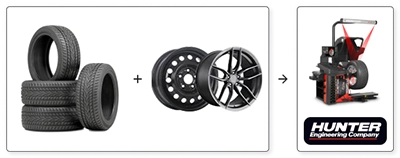The difference between studded and non-studded winter tires: Advantages, disadvantages, and recommendations

Winter in Canada imposes challenging driving conditions. Therefore, it's crucial to choose your winter tires wisely. Among the available options, you can opt for studded tires, studdable tires, or non-studded tires. But what are the differences between these types of tires? In this article, we will examine their advantages, disadvantages, and in which cases each type is recommended.
1. What are studded winter tires?
Studded tires are equipped with small metal spikes embedded in the tread, providing better traction on icy or snowy surfaces.

a) Studdable tires
Studdable tires are sold without studs but have the capability to be studded later by a professional. This allows you to decide if you need studs depending on the winter conditions.

b) Factory-studded tires
Factory-studded tires come with studs already installed. They are ready to use immediately and offer optimized studding quality by the manufacturer.
2. Advantages of studded tires
- Maximum traction on ice: The studs bite into the ice, offering unmatched grip.
- Safety in extreme conditions: Ideal for regions where roads remain icy for much of the winter, like northern Alberta (e.g., Fort McMurray) or rural areas of British Columbia, where temperatures frequently drop in winter.
- Improved performance on compacted snow: The studs help maintain better traction on packed snow, ideal in regions like Charlevoix in Quebec or the Rocky Mountains in British Columbia.
Specific advantages:
- Studdable tires: Flexibility to decide whether to install studs based on your needs. This can be useful if you live in a region with variable winters, like Ottawa or Montreal.
- Factory-studded tires: Perfect installation of studs ensures maximum efficiency and longevity.
3. Disadvantages of studded tires
- Noise on asphalt: The studs can generate more noise when driving on dry roads, which is often the case in large cities such as Toronto or Vancouver, where the use of studded tires is less common.
- Road wear: Studded tires can accelerate the wear of some asphalt roads.
- Strict regulations: The use of studded tires is limited in some provinces, such as Ontario, where their use is prohibited except in the north of the province.
4. What are non-studded winter tires?
Non-studded tires, or "friction tires," rely solely on their design and materials to offer maximum traction in a variety of winter conditions.
5. Advantages of non-studded tires
- Less noisy: Without studs, these tires offer a quieter ride, especially on dry roads in urban areas such as Montreal, Calgary, or Toronto.
- Good traction on fresh snow: Their design is often optimized for traction on fresh and wet snow, making them a good choice for cities like Quebec City or Halifax.
- No legal restrictions: Unlike studded tires, they can be used anywhere throughout the winter.
6. Disadvantages of non-studded tires
- Reduced traction on ice: They cannot compete with studded tires on icy surfaces, which is important in regions such as northern Alberta or some parts of rural Ontario.
- Variable performance: While some models offer excellent traction, they are not as versatile in extreme conditions as studded tires.
7. In which cases should you choose each type of tire?
- Studded or studdable tires: Ideal if you live in a region where roads are often icy or if you frequently drive on mountain roads. For example, if you live in northern Quebec or the Rocky Mountains in British Columbia, studded tires offer increased safety.
- Non-studded tires: Perfect for drivers in urban areas or regions where roads are mostly snowy but not icy, such as in cities like Montreal, Toronto, or Ottawa. They are also recommended if you are looking for a quieter and more comfortable ride.
Conclusion
The choice between studded, studdable, or non-studded winter tires primarily depends on the climate conditions in which you drive. For icy or frozen roads, studded tires, whether factory-studded or studdable, offer the best safety. In contrast, for less extreme conditions, non-studded tires remain a versatile and efficient option.
Dominic Vaillancourt
Automotive expert & Spokesperson


